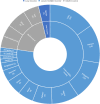Neglected gaps in improving the health, wellbeing, and care for sexual and gender minority young people living in low- and lower-middle- income countries: a scoping review
- PMID: 37648963
- PMCID: PMC10466764
- DOI: 10.1186/s12889-023-16443-8
Neglected gaps in improving the health, wellbeing, and care for sexual and gender minority young people living in low- and lower-middle- income countries: a scoping review
Abstract
Background: There is a lack of reliable data on the size, characteristics, and experiences of sexual and gender minority (SGM) young people (ages 10-24) in low- and lower-middle- income countries (LMICs). This review examines the research conducted in the last thirteen years with and about SGM young people living in low-income settings and seeks to answer the question: What is known about the mental and physical health needs, safety, and wellbeing of SGM young people living in LMICs?
Methods: We conducted a scoping review informed by the methodological frameworks put forth by Arksey and O'Malley and the Joanna Briggs Institute. We systematically searched two general social science databases and one topic-specific database for peer-reviewed papers, of any research design, that included SGM young people or explored attitudes toward SGM young people in LMICs. We included papers that reported on factors influencing the health and wellbeing of SGM populations, including physical and mental health, healthcare-seeking behaviors, substance use, experiences of discrimination and/or stigma, experiences of violence and abuse (emotional, physical, and/or sexual), economically motivated paid sex practices, housing or economic security, and attitudes of others toward SGM populations.
Results: Of the 5,409 unique records identified, 79 papers drawing from data collected from 74 unique studies met the inclusion criteria. Only 50 of the 79 papers included SGM young people as participants, with just 13 focusing exclusively on SGM young people ages 10-24. The included papers were classified into three thematic groupings: attitudes toward SGM populations (n = 26), risks to health (n = 40), and experiences of stigma and discrimination (n = 13).
Conclusion: The findings indicate that the health and wellbeing of SGM young people in LMICs has been historically under-researched. While SGM young people have received more attention from researchers in recent years, the body of literature as a whole is disjointed and sparse, and often studies are about SGM young people, rather than with and for them. Our review highlights the need for more and better research, more accurate and disaggregated demographic data, and leadership and participation of SGM-led community-based organizations in the co-design of studies that focus on SGM young people.
Keywords: Adolescent health; Adolescent wellbeing; LGBTQ; LMICs; Majority World; Scoping review; Sexual and gender minority; Youth.
© 2023. BioMed Central Ltd., part of Springer Nature.
Conflict of interest statement
The authors declare that they have no competing interests.
Figures
Similar articles
-
Health disparities in one of the world's most progressive countries: a scoping review of mental health and substance use among sexual and gender minority people in the Netherlands.BMC Public Health. 2023 Dec 18;23(1):2533. doi: 10.1186/s12889-023-17466-x. BMC Public Health. 2023. PMID: 38110908 Free PMC article.
-
Health Experiences of Sexual and Gender Minority People Living With Dementia and Their Care Partners: Protocol for a Scoping Review.JMIR Res Protoc. 2023 Mar 13;12:e44918. doi: 10.2196/44918. JMIR Res Protoc. 2023. PMID: 36757411 Free PMC article.
-
Mental Health Challenges and Needs among Sexual and Gender Minority People in Western Kenya.Int J Environ Res Public Health. 2021 Feb 1;18(3):1311. doi: 10.3390/ijerph18031311. Int J Environ Res Public Health. 2021. PMID: 33535647 Free PMC article.
-
A Scoping Review of the Experiences of Violence and Abuse Among Sexual and Gender Minority Migrants Across the Migration Trajectory.Trauma Violence Abuse. 2021 Dec;22(5):1339-1355. doi: 10.1177/15248380211043892. Epub 2021 Nov 23. Trauma Violence Abuse. 2021. PMID: 34812109
-
Approaching sexuality in LGBTQIAP + patients with cancer: scoping review.BMC Public Health. 2023 Jun 30;23(1):1269. doi: 10.1186/s12889-023-16170-0. BMC Public Health. 2023. PMID: 37391788 Free PMC article.
References
-
- UN Department of Economic and Social Affairs . World Population Prospects 2019. New York: United Nations; 2019.
-
- O’Malley J, Holzinger A. The Sustainable Development Goals: Sexual and Gender Minorities. United Nations Development Programme, https://www.undp.org/publications/sexual-and-gender-minorities (2018).
-
- Conron KJ. LGBT Youth Population in the United States. Fact Sheet, The Williams Institute, UCLA, https://williamsinstitute.law.ucla.edu/publications/lgbt-youth-pop-us/ (Sept 2020, Accessed 19 Nov 2021).
Publication types
MeSH terms
LinkOut - more resources
Full Text Sources
Miscellaneous



